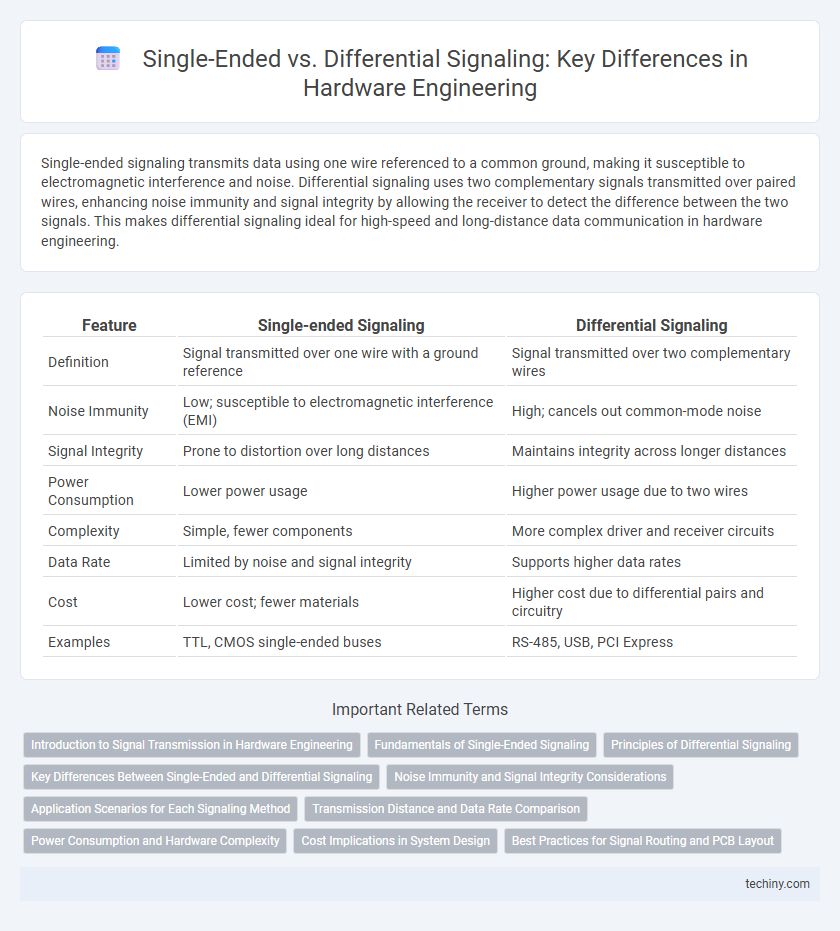Single-ended signaling transmits data using one wire referenced to a common ground, making it susceptible to electromagnetic interference and noise. Differential signaling uses two complementary signals transmitted over paired wires, enhancing noise immunity and signal integrity by allowing the receiver to detect the difference between the two signals. This makes differential signaling ideal for high-speed and long-distance data communication in hardware engineering.
Table of Comparison
| Feature | Single-ended Signaling | Differential Signaling |
|---|---|---|
| Definition | Signal transmitted over one wire with a ground reference | Signal transmitted over two complementary wires |
| Noise Immunity | Low; susceptible to electromagnetic interference (EMI) | High; cancels out common-mode noise |
| Signal Integrity | Prone to distortion over long distances | Maintains integrity across longer distances |
| Power Consumption | Lower power usage | Higher power usage due to two wires |
| Complexity | Simple, fewer components | More complex driver and receiver circuits |
| Data Rate | Limited by noise and signal integrity | Supports higher data rates |
| Cost | Lower cost; fewer materials | Higher cost due to differential pairs and circuitry |
| Examples | TTL, CMOS single-ended buses | RS-485, USB, PCI Express |
Introduction to Signal Transmission in Hardware Engineering
Single-ended signaling transmits electrical signals using one conductor referenced to a common ground, making it simpler but more susceptible to noise and interference. Differential signaling employs two complementary signals sent over paired conductors, enhancing noise immunity and signal integrity in high-speed hardware communication. Understanding the trade-offs between single-ended and differential signaling is crucial for designing robust, efficient hardware transmission systems.
Fundamentals of Single-Ended Signaling
Single-ended signaling transmits data using one signal line referenced to a common ground, making it simpler but more susceptible to noise and electromagnetic interference. This method is widely used in low-speed, short-distance applications due to its straightforward design and lower cost. Signal integrity in single-ended systems depends heavily on maintaining a stable ground reference and minimizing interference from external sources.
Principles of Differential Signaling
Differential signaling transmits two complementary signals through paired conductors, improving noise immunity by allowing the receiver to distinguish original data from external interference. The principle relies on measuring the voltage difference between the two lines rather than referencing a single-ended signal to ground, which reduces susceptibility to electromagnetic noise and crosstalk. This technique enhances signal integrity and enables higher data transfer rates in hardware engineering applications, especially in high-speed digital and communication systems.
Key Differences Between Single-Ended and Differential Signaling
Single-ended signaling uses one signal wire referenced to a common ground, making it more vulnerable to noise and signal degradation over long distances, while differential signaling transmits two complementary signals, enhancing noise immunity and signal integrity. Differential signaling offers better performance in high-speed and high-frequency applications due to reduced electromagnetic interference (EMI) and crosstalk. Single-ended designs are simpler and lower cost but less effective in environments with high electrical noise or long cable runs.
Noise Immunity and Signal Integrity Considerations
Differential signaling provides superior noise immunity by transmitting two complementary signals, allowing the receiver to reject common-mode noise and maintain high signal integrity in electrically noisy environments. Single-ended signaling is more susceptible to electromagnetic interference (EMI) and crosstalk, resulting in degraded signal quality over longer distances or higher frequencies. Proper impedance matching and layout design are crucial for both methods, but differential signaling inherently offers better performance in preserving signal integrity.
Application Scenarios for Each Signaling Method
Single-ended signaling is commonly used in low-speed, short-distance applications such as microcontroller I/O pins and simple sensor interfaces where cost and simplicity are prioritized. Differential signaling excels in high-speed, long-distance communication environments like Ethernet, USB, and HDMI due to its superior noise immunity and signal integrity. Automotive networks and high-frequency data transmission systems frequently rely on differential pairs to maintain reliable data transfer amid electromagnetic interference.
Transmission Distance and Data Rate Comparison
Single-ended signaling typically supports shorter transmission distances and lower data rates due to susceptibility to electromagnetic interference and signal degradation. Differential signaling enables longer transmission distances and higher data rates by transmitting two complementary signals, which enhances noise immunity and signal integrity. Consequently, differential signaling is preferred in high-speed and long-distance hardware communication applications.
Power Consumption and Hardware Complexity
Single-ended signaling consumes less power due to its simplicity but tends to suffer from higher noise susceptibility, requiring additional filtering components that may increase hardware complexity. Differential signaling, while consuming more power because of its dual-line transmission, offers improved noise immunity and signal integrity, which can reduce errors and troubleshooting efforts in complex hardware designs. The trade-off between power consumption and hardware complexity often guides engineers in choosing the appropriate signaling method based on application-specific requirements such as data rate and environmental noise.
Cost Implications in System Design
Single-ended signaling requires fewer components and simpler PCB layout, leading to lower initial costs in system design. Differential signaling, while more expensive due to the need for matched pair lines and differential receivers, offers improved noise immunity and signal integrity, potentially reducing long-term maintenance and error correction expenses. Cost-benefit analysis must consider these trade-offs, especially in high-speed or noisy environments where differential signaling can prevent costly system failures.
Best Practices for Signal Routing and PCB Layout
In hardware engineering, best practices for signal routing and PCB layout emphasize minimizing noise and crosstalk by using differential signaling over single-ended signaling whenever possible due to its improved immunity to electromagnetic interference (EMI). Differential pairs should be routed with controlled impedance and consistent spacing to maintain signal integrity and reduce skew, while single-ended traces require careful length matching and proper grounding to minimize interference. Implementing proper termination techniques and avoiding stubs or vias along differential routes further optimizes signal quality and overall performance in high-speed PCB designs.
Single-ended vs Differential signaling Infographic

 techiny.com
techiny.com